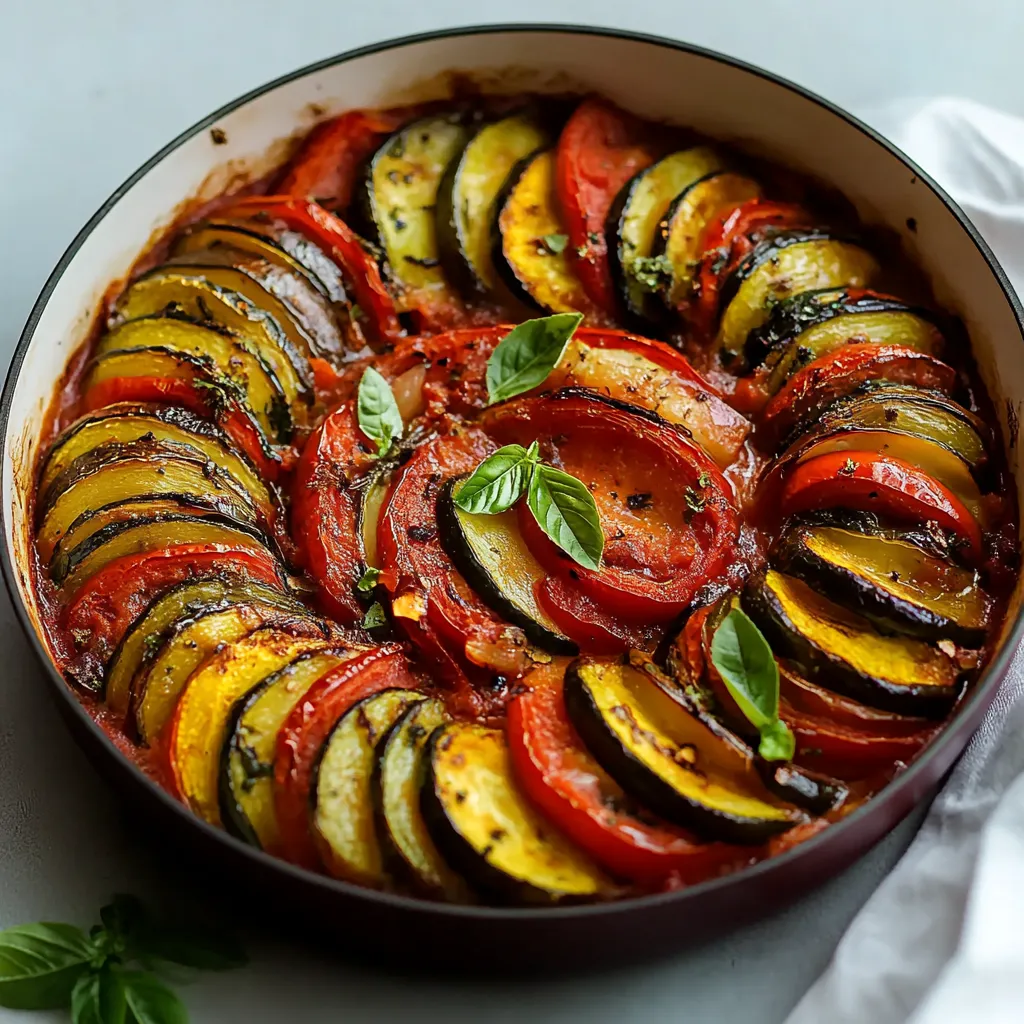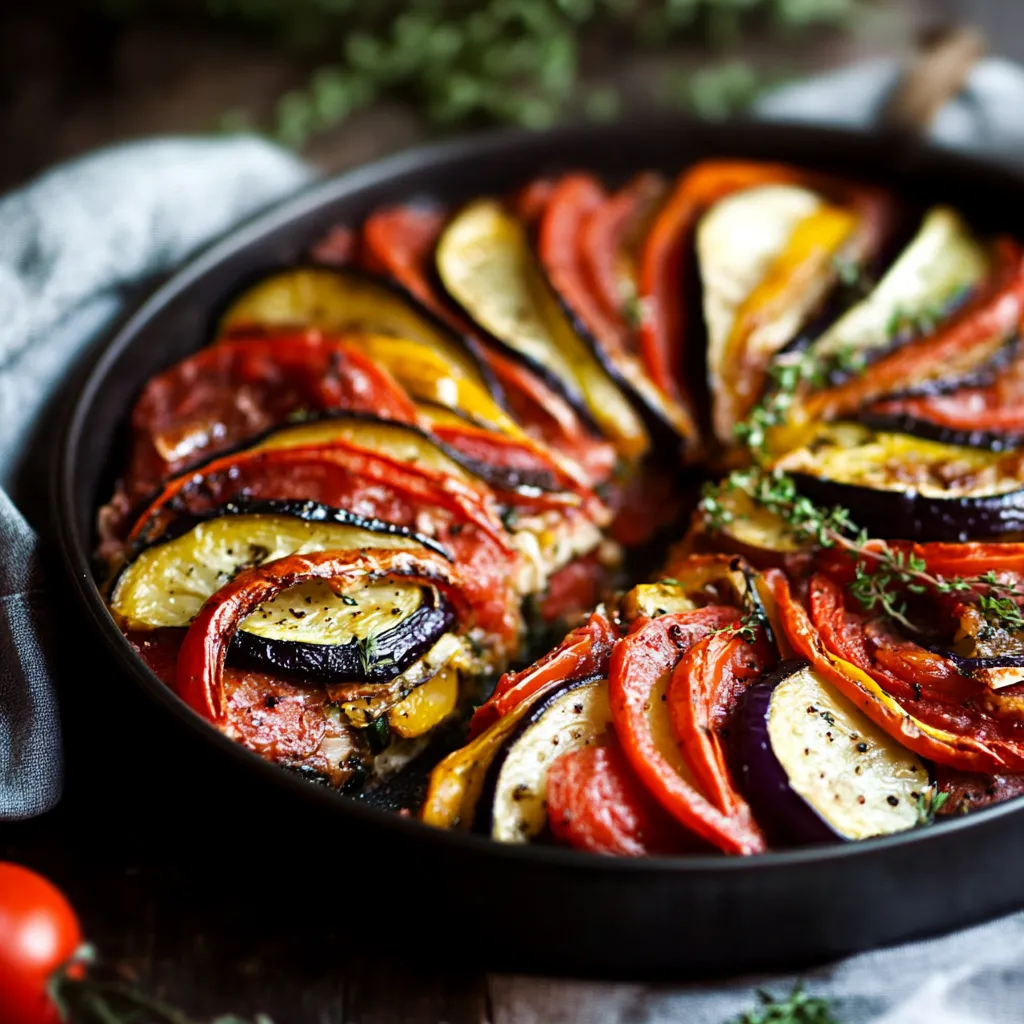 Pin it
Pin it
French ratatouille transforms humble summer vegetables into a symphony of flavors through patient cooking and thoughtful seasoning. This Provençal stew showcases eggplant, zucchini, bell peppers, and tomatoes in their peak season, allowing each ingredient to maintain its integrity while melding into a cohesive, richly flavored dish.
I first encountered authentic ratatouille while traveling through the south of France. Sitting at a small café in Nice, I watched an elderly chef carefully tend to a pot of simmering vegetables. The result was astonishing—vegetables I’d eaten all my life transformed into something so complex and satisfying. Now, my family knows summer has arrived when the first batch of ratatouille appears on our table.
Ingredients List
- Eggplant: Provides a meaty texture that absorbs olive oil and flavors beautifully.
- Zucchini: Adds delicate flavor and a tender contrast to eggplant.
- Bell peppers: Contribute sweetness and vibrant color to balance the dish.
- Tomatoes: Provide acidity and form the light sauce that ties everything together.
- Onions: Offer depth and natural sweetness as the aromatic base.
- Garlic: Intensifies the Mediterranean character with pungent, earthy notes.
- Fresh herbs: Thyme, basil, and bay leaves create layers of herbal complexity.
- Olive oil: Essential for developing flavor and carrying the rich Mediterranean essence.
Cooking Method
- Prepare Vegetables Thoughtfully:
- Wash and cut the eggplant into 1-inch cubes, sprinkle with salt, and let sit for 30 minutes to remove bitterness. Dice zucchini, bell peppers, tomatoes, and onions into uniform sizes for even cooking. Mince garlic just before using.
- Create Aromatic Foundation:
- Heat ¼ cup olive oil in a large pot over medium heat. Sauté onions with a pinch of salt for 5-7 minutes until translucent. Add minced garlic and cook for 1 minute until fragrant.
- Cook Vegetables in Stages:
- Rinse and dry eggplant, then add to the pot with more olive oil. Cook for 8-10 minutes until softened. Stir in bell peppers and cook for 5 more minutes, then add zucchini and continue cooking for another 5 minutes.
- Introduce Tomatoes and Herbs:
- Add diced tomatoes, thyme, bay leaves, salt, and pepper. Stir gently to combine, allowing the tomatoes to release their juices and form a sauce.
- Simmer with Patience:
- Reduce heat to low, cover, and let simmer for 30-40 minutes, stirring occasionally. Vegetables should be tender but maintain their shape.
- Rest for Flavor Development:
- Let ratatouille sit, covered, for at least 30 minutes before serving to allow flavors to meld.
- Adjust Final Seasoning:
- Before serving, remove bay leaves and stir in fresh basil. Adjust salt and pepper to taste. Drizzle with extra virgin olive oil for added richness.
- Serve at Proper Temperature:
- Enjoy warm, at room temperature, or chilled based on preference.
 Pin it
Pin it
My first attempts at ratatouille lacked balance until I learned the importance of cooking vegetables in stages. Adding everything at once resulted in mushy textures. A Provençal chef once told me, 'Each vegetable must be introduced when it is ready to meet the others.' This wisdom transformed my approach, ensuring perfectly tender yet distinct vegetables.
Serving Suggestions
Serve over creamy Parmesan polenta for a satisfying contrast of textures.
Fill hollowed tomatoes or bell peppers with ratatouille and bake for an elegant appetizer.
Top warm ratatouille with a poached egg and serve alongside crusty bread.
Regional Variations
Try the Niçoise version by cooking each vegetable separately before combining for distinct textures.
Add capers, olives, and vinegar for a Sicilian-inspired twist.
Incorporate smoked paprika and manchego cheese for a Spanish variation.
Storage Wisdom
Refrigerate in an airtight container for up to five days, as flavors deepen over time.
Freeze for up to three months, though texture may soften upon thawing.
Use leftovers as a pasta sauce, bruschetta topping, or omelet filling.
 Pin it
Pin it
This classic French ratatouille is a true celebration of summer’s best produce. It has taught me the importance of patience in cooking—allowing flavors to build naturally. Whether served warm with crusty bread or chilled on a hot day, it always transports me back to the Mediterranean, where simple ingredients shine with careful preparation.
Frequently Asked Questions
- → Do I need to peel the eggplant for ratatouille?
- Peeling eggplant is optional for ratatouille. The skin adds color and texture, but if you prefer a softer consistency or are using larger, more mature eggplants with tougher skin, you may want to peel them.
- → Can I make ratatouille ahead of time?
- Ratatouille actually improves with time as the flavors meld together. You can make it 1-2 days ahead and refrigerate it. Bring it to room temperature or gently reheat before serving.
- → How can I prevent my ratatouille from becoming too watery?
- If your vegetables release too much liquid, you can uncover the pot during the last 10-15 minutes of cooking to allow excess moisture to evaporate. Using ripe but firm vegetables also helps control moisture.
- → What can I serve with ratatouille?
- Ratatouille pairs beautifully with crusty bread, over polenta or rice, alongside grilled meats or fish, or with a dollop of goat cheese. It's also excellent with a fried or poached egg on top.
- → Can I freeze ratatouille?
- Yes, ratatouille freezes well for up to 3 months. Cool it completely before transferring to freezer-safe containers. Thaw overnight in the refrigerator and gently reheat on the stovetop.
